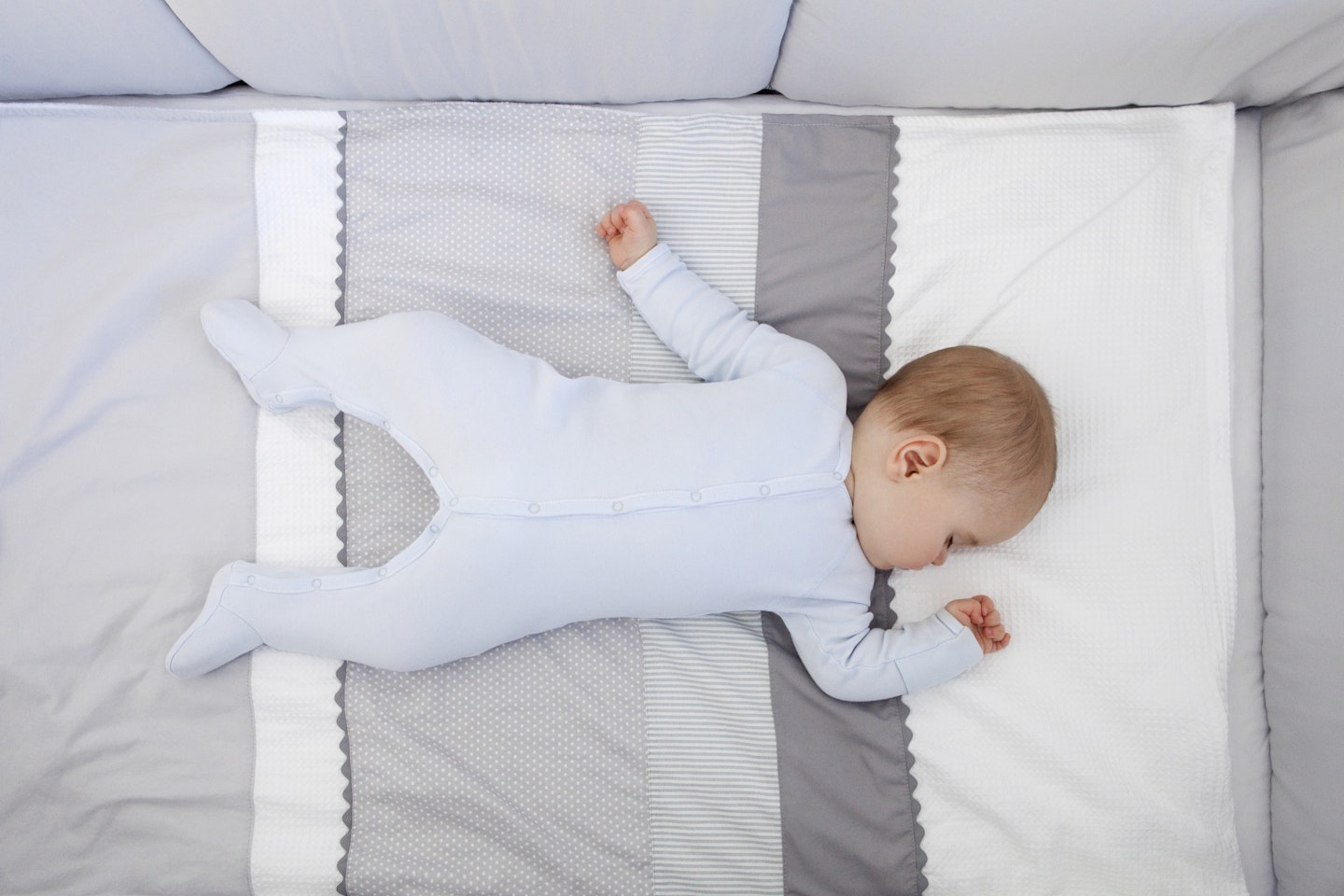
Expert Consulted: Katherine Walker, NCT Practitioner
A stuffy nose can make sleep tricky for babies and parents trying to soothe them. While nasal congestion is often more common during the winter months due to common colds, it can affect babies at any time of year. From residual fluid in newborns’ nasal passages to allergies, respiratory syncytial virus or other viral infections in older infants, there are many reasons your little one might be sniffling. Knowing the best sleeping position for a baby with a stuffy nose is essential for easing discomfort and supporting safer, more restful sleep.
In this article:
In this article, we’ll explore expert advice on sleep positioning, baby-safe remedies to relieve nasal congestion, and what to watch out for when your baby is feeling under the weather. We spoke to Katherine Walker, a Service Development Manager at the National Childbirth Trust (NCT), to bring you expert-backed tips for easing their discomfort, promoting healthy sleep and keeping healthy in winter.
What is the best sleeping position for a baby with a stuffy nose?

NHS guidance states that the safest sleeping position for any baby, even with a stuffy nose, is always on their back. This means placing your little one flat on their back in their cot or Moses basket, not propped up or on their tummy or side. Sleeping on their back helps keep your baby’s airway open and is proven to reduce the risk of SIDS (sudden infant death syndrome). No matter how congested your baby might seem, back sleeping is still best.
According to Katherine, in line with current safe sleeping regulations, "There is no change to safer sleep guidance for a baby with a stuffy nose, the advice remains that babies should sleep on a firm flat surface in a cot, crib or Moses basket, which is kept clear of any extra items, such as loose bedding or toys."
This means there is no need to prop up the baby mattress or cot at one end, or prop up your baby with extra bedding. As the NHS and charities such as The Lullaby Trust outlined, 'The safest place for a baby to sleep is in their own clear, flat, separate sleep space (e.g. a cot or Moses basket) in the same room as you.'
What is the best way to soothe a baby with a blocked nose?
If your baby is trying to sleep, but you're struggling to soothe them due to their blocked nose, then Katherine explained that increased humidity can help, saying: "A bowl of warm water in their room at night or a humidifier may help with this."
Air in the bedroom with added moisture, whether from a bowl of water or a humidifier, can soothe dry nasal passages, ease breathing, and improve sleep quality for your little one. Several products on the market, such as Calpol Vapour Plug and Nightlight, Olbas Oil, or Vicks Vapour Rub, can also help ease a baby's stuffy nose.
How can I help clear my baby’s congestion?
A blocked nose can make sleep (for everyone!) challenging, but there are safe ways to ease your baby’s congestion:
• Saline drops or spray: These are gentle and suitable from birth. A couple of saline drops in each nostril can loosen mucus, making breathing easier for your baby. We love Snufflebabe Nasal Spray.
• Bulb syringe or nasal aspirator: These handy tools can gently suction out loosened mucus after you’ve used saline drops. Always follow the instructions and don’t overuse, as it may irritate the nose. We found that the Frida Baby Snotsucker is the best (even if the name sounds gross).
• Baby humidifier: Try a baby humidifier in your baby's room to keep the air moist, which can help soothe swollen nasal passages, especially in the winter months.
• Steam: Sit in the bathroom with your baby while you run a hot shower (not with the baby in the shower). The steam can help clear little noses naturally.
• Keep baby upright when awake: Plenty of cuddles in a more upright position during the day (such as in your arms or a sling) can also encourage mucus to drain.
What causes a stuffy nose in babies, and what is the best way to treat it?
A stuffy or blocked nose can be caused by a number of reasons, including, as previously mentioned, a baby's mucus or a cold. As Katherine explained, "It’s normal for babies to have mucus, and this can cause a stuffy nose. However, it can be hard for them to clear the mucus, as they are unable to do this on their own.
"Making the environment more humid can help, as well as using saline drops, which can help to loosen the mucus. Feeding regularly keeps your baby well hydrated, which can also help to keep the mucus looser."
You may also find it useful to clear a baby's nose using a nasal aspirator or simply using a soft tissue to wipe away anything.
When to seek medical advice about your baby’s stuffy nose
In most cases, a baby’s cold or stuffy nose will clear up on its own within a week. While nasal congestion can be uncomfortable, it’s usually harmless and part of the body’s natural response to viruses or irritants. That said, it’s important to trust your instincts as a parent. If your baby’s stuffy nose persists for more than three weeks or develops a fever or seems unusually unwell, it’s a good idea to speak with your GP or health visitor for reassurance and advice.
See your GP or call 111 if:
• Your baby is under 3 months and has a temperature of 38°C or above
• They’re not feeding well or having fewer wet nappies than usual
• Their breathing is laboured, noisy, or they're grunting/wheezing
• They’re unusually lethargic, irritable, or won’t settle
• You notice any blue tint to their lips or skin
You know your baby best. If something doesn’t feel right, it’s always okay to seek medical advice.
FAQs
Is it safe to elevate a baby’s head for congestion?
You should never use loose pillows or cushions in the crib. However, you can safely elevate the head end of your baby’s mattress slightly (for example, by placing a rolled towel under the mattress, not the baby) to help with drainage.
Why does baby nasal congestion often feel worse at night?
When babies lie flat, blood flow increases to the upper body and nasal tissues, which can cause swelling in their nasal passages and make mucus seem more persistent, especially at night when natural cortisol levels dip. Adding moisture (like with a cool‑mist humidifier or steam session) can help.
What home remedies help soothe a congested baby at bedtime?
Try a few gentle, baby-safe options: use saline drops to loosen mucus, suction with a nasal aspirator, and run a cool‑mist humidifier or steamy bathroom session before sleep. Keep your baby hydrated with extra feeds. Avoid the overuse of suction or warm-mist devices and never use menthol rubs on children under one.
About the expert
Katherine Walker is the Service Development Manager at NCT, where she oversees parent insight and evaluation and uses these insights to improve services for all parents. She has extensive experience as an NCT Practitioner since 2009, working directly with parents and training NCT Practitioners to ensure baby safety, including safe sleeping.
Katherine has a BA (Hons) Birth and Beyond Educator and a Postgraduate certificate in Learning and Teaching in Higher Education, making her a Fellow of the Higher Education Academy.
About the author
Anna Sky Magliola is a freelance writer for Mother&Baby. She's a mum to a three-year-old little girl and has worked for Bauer Media (Mother&Baby's parent company) for 17 years as a digital editor. She has been the volunteer branch coordinator for NCT Preston for three years.
